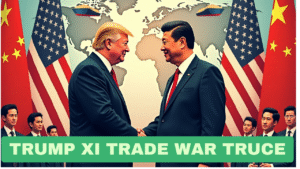Table of Contents
Alt text: Trump Xi trade war truce negotiation table

1. Introduction: Why the Trump Xi Trade War Truce Matters in 2025 <a name=”introduction”></a>
The Trump Xi trade war truce continues to shape global economics even in 2025. Originally sparked by tariff disputes, this historic standoff between the world’s top two economies has evolved into a complex game of technology, supply chains, and strategic influence. Now that fresh negotiations are underway in London, it’s crucial to understand how past decisions influence current policy and future outcomes.
2. Timeline of the Trump Xi Trade War <a name=”timeline”></a>
To grasp the importance of the Trump Xi trade war truce, here’s a quick look at its evolution:
| Year | Event |
|---|---|
| 2018 | Trump imposes tariffs on $34 billion worth of Chinese goods. |
| 2019 | Tariffs escalate; China retaliates with duties on U.S. imports. |
| 2020 | “Phase One” agreement signed. China agrees to purchase U.S. goods. |
| 2021 | Tensions ease, but tech sanctions continue. |
| 2023 | Semiconductor shortages reignite talks. |
| 2025 | Truce reassessed at London Summit. |
Internal link: See our full U.S.-China tariff timeline
3. What Triggered the Trade Truce? <a name=”triggered”></a>
The original Trump Xi trade war truce was born from mutual exhaustion. Both economies were suffering—China’s manufacturing slowed due to export bans, and the U.S. saw rising inflation. The 2020 “Phase One” agreement was a temporary fix that paused escalation but didn’t resolve deeper issues like:
-
Intellectual property theft
-
Forced tech transfers
-
Export restrictions on critical goods
In 2025, these same issues are back on the table—alongside new digital and AI concerns.
4. Economic Impacts: Winners and Losers <a name=”economic-impacts”></a>
Who Benefited?
-
Vietnam & India: Surged as alternative manufacturing hubs.
-
American soybean farmers: Gained from China’s agreed imports post-truce.
-
Rare earth miners outside China: Experienced investment boosts.
Who Suffered?
-
U.S. consumers: Paid higher prices due to tariffs.
-
Tech companies: Cut off from Chinese components and buyers.
-
Chinese exporters: Lost access to high-end Western tech.
These impacts show the wide-reaching effects of the Trump Xi trade war truce.
5. Key Figures in the 2025 Trade Talks <a name=”key-figures”></a>
U.S. Representatives
-
Scott Bessent: Market-focused strategist aiming for investor protection.
-
Jamieson Greer: Legal architect of past U.S. trade actions.
Chinese Delegates
-
He Lifeng: A key economic advisor seeking long-term stability and tech independence.
Their diplomacy could shape the next decade of trade rules.
6. Tech Tensions After the Truce <a name=”tech”></a>
The Trump Xi trade war truce hasn’t stopped tech tension—it merely postponed it. Today’s disputes include:
-
Semiconductor bans
-
AI surveillance tools
-
5G infrastructure policies
Example: U.S. companies like NVIDIA still require licenses to sell chips to Chinese AI startups. China, in turn, is investing billions in self-sufficient tech sectors.
External Dofollow Link:
U.S. Department of Commerce – Export Controls
7. Rare Earth Supply Chain: China’s Hidden Weapon <a name=”rare-earth”></a>
China controls over 60% of global rare earth exports, which are vital for:
-
Smartphones
-
EV batteries
-
Defense systems
In 2025, Beijing has tightened export controls, especially to U.S.-aligned nations. This weaponization has triggered:
-
Price hikes globally
-
Western search for alternatives in Africa and Australia
-
Increased recycling investments
External Dofollow Link:
U.S. Geological Survey: Rare Earth Statistics
8. Global Responses to the Trump Xi Trade War Truce <a name=”global-response”></a>
European Union:
-
Focused on digital sovereignty and protecting IP.
Japan & South Korea:
-
Strengthening chip alliances with the U.S.
India:
-
Pitched itself as a “neutral hub” for semiconductors and auto parts.
Internal Link: How India is rising amid U.S.-China tech decoupling
9. 2025 Forecast: What’s Next for U.S.-China Relations? <a name=”forecast”></a>
🔍 Digital Trade Frameworks
-
Cloud computing rules
-
Cross-border data storage
💡 Green Tech Diplomacy
-
Carbon-based trade tariffs
-
EV battery sourcing limits
🚫 Military-Tech Barriers
-
Ban on quantum computing exports
-
Controls on aerospace components
The Trump Xi trade war truce is morphing into a policy framework for the digital age.
10. Conclusion: The Bigger Picture Behind the Truce <a name=”conclusion”></a>
The Trump Xi trade war truce was more than a pause in tariffs—it was a strategic recalibration. Both powers have learned that economic warfare has limitations, and diplomacy is inevitable. In 2025, the stakes are higher, and the outcomes will affect:
-
Global inflation
-
Supply chain resilience
-
Geopolitical alliances
The world isn’t just watching—it’s adapting.